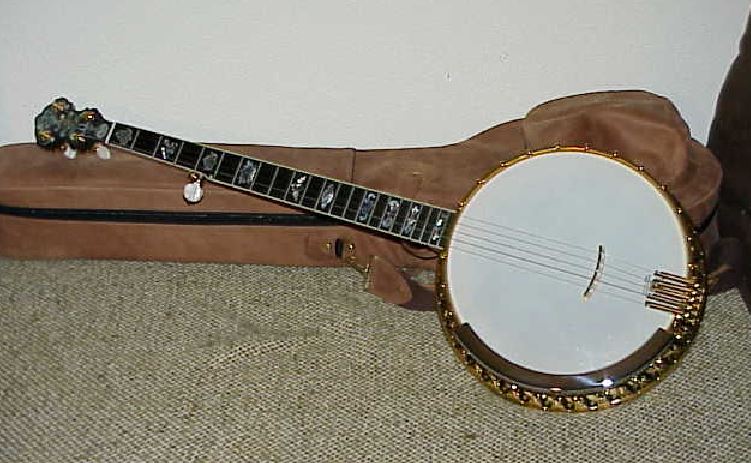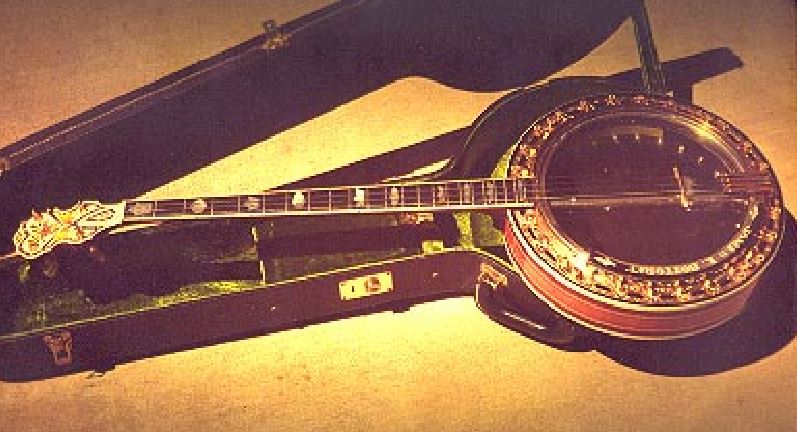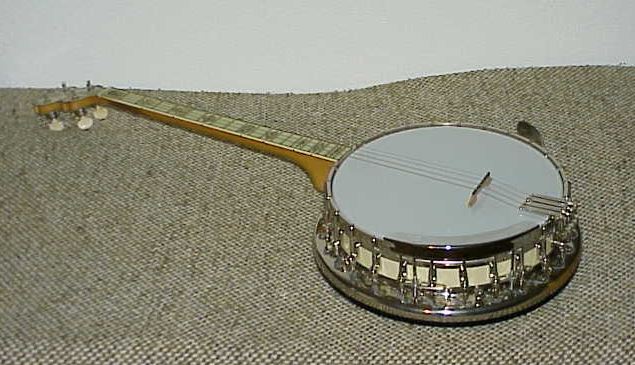-
- Jim Bottorff's
Banjo Page
- TIPS ON LEARNING
TO PLAY THE BANJO

-
- Types of
Banjos Getting Started
-
- Return to Home Page
- Return to Song
Catagories
- Go to Beginner's Songs
- Go to Instruction
Items
- Go to Easy Play-Along
Songs
- Go to Performer Links
page
- Website Search
- Go to bottom of this page
-
- TYPES OF BANJOS
-
- 5-String Banjo

-
- The 5-String banjo has five
strings and a neck with 22 frets. The 5th string is a short
string on the side of the neck.
- Lots of styles of playing
are used including finger picking and strumming both with and
without finger picks.
- Different tunings are used
on the 5-string. The two most common are "G" (gDGBD)
and "C" (gCGBD).
- The many tunings allow more
open string chords for easier finger picking. Capos are
often used to change keys.
-
- 4-String Plectrum
Banjo

-
- The 4-String Plectrum banjo
has four strings and a neck with 22 frets. Same as a 5-String
without the 5th string.
- Standard tuning is "C"
(CGBD). Other popular tunings include "G" (DGBD)
and "Guitar" (DGBE).
- The most common styles of
playing include using a flat guitar pick to play single strings
and chords.
- Playing in different keys
is accomplished by learning chords for that key. Capos
are seldom used.
-
- 4-String Tenor
Banjo

-
- The 4-String Tenor banjo
has four strings and a short neck with 19 or 17 frets.
- Standard tuning is "Tenor"
(CGDA). Alternate tunings include "Irish Tenor"
(GDAE), plus "Plectrum" and "Guitar".
- The most common styles of
playing use a flat guitar pick to play single strings and chords.
- Playing in different keys
is accomplished by learning chords for that key. Capos
are seldom used.
-
- Click
here for additional information on banjos (Wikipedia)
-
-
- GETTING STARTED

-
- To get started, visit a local music
store or Internet sites and explore their selection of banjo
books. Look for a book that aligns with your specific interest
(5-String, Plectrum, or Tenor banjo) and covers tuning methods,
music fundamentals, chord exercises, and includes a few songs
to practice. The Mel-Bay company has a large number of beginning
and advanced publications. For those interested in older
banjo instruction, keep an eye out for books by Harry Reser and
Roy Smeck. While both were renowned for their tenor banjo skills,
they also authored books covering various types of banjos. You
can often find their works on platforms like eBay and other online
marketplaces.
-
- If you like folk and bluegrass music,
Pete Seeger's "How to play the 5-string Banjo" book
and recording have a lot of variety with examples of many styles
of strumming and finger-picking. Some banjo books focus
on only one style of playing, such as frailing, 3-finger picking,
single-string melody, or chord-melody. These are good if
you know what playing style you want to learn. If you are not
sure what style you are interested in, stay with the books that
show music basics and simple songs with chord diagrams. Following
are some links that may be helpful:
-
- The Banjo
Styles Collage
-
- Pete
Seeger 5-String Banjo Basic Strumming
-
- 3-Finger Picking
Samples
-
- Eddie Peabody 4-String
Banjo Lessons
-
- Dave
Marty's 4-String Banjo Workshop Videos
-
-
- Don't overlook your local city and
county libraries! They often house a treasure trove of books
and recordings that might be out of print or hard to find elsewhere.
Plus, most libraries offer internet access, so you can easily
look up reviews of any books you discover. Don't overlook your
local city and county libraries! They often house a treasure
trove of books and recordings that might be out of print or hard
to find elsewhere. Plus, most libraries offer internet access,
so you can easily look up reviews of any books you discover.
-
- Learn to tune the banjo by various
methods such as, electronic tuner, piano, pitch pipe, tuning
fork, other instruments, and relative-tuning. The relative-tuning
is explained in most beginning books and this should be one of
the first things you learn on the banjo. Always check the
tuning before playing or practicing. Being able to stay
in tune is very important.
-
- Learn the left hand chord positions
for C, F, G7 and then G, C, D7, playing them in that order. Use
a flat guitar type pick, your fingers, or the back of your finger
nails, to strum/pick the strings. Don't be concerned with
rhythm or anything else until you can make each chord sound clear
and loud without buzzing or sounding muted. Practice, practice,
practice. As you hold the chord, strike each string separately
to make sure you are getting clean, clear sounds. Getting
a clear sound from each string is very important. Press the strings
down between the fret bars, not on top of the fret.
Once you have learned to tune the banjo easily and make clear
sounding chords, then it's time to continue on with your
choice of right hand techniques, such as flat-picking, frailing,
finger-picking, etc. Rhythm, timing, and speed of changing
chords will come with practice. "Skip
To My Lou," "Down In The Valley,"
"Camptown Races,"
and "Buffalo Gals" are typical of the types of songs to
practice. Play chord accompaniment and then progress to melody
techniques.
-
- Immerse yourself in the world of
banjo music by listening to and watching as many banjo players
as you can. As you do, identify the playing style(s) that resonate
with you most. Once you have a sense of your preferred style,
seek out a local banjo teacher who can guide you through music
fundamentals, rhythm, timing, and help you learn some songs.
Have your banjo checked-out and adjusted by someone with banjo
knowledge. Watch while they do it and have them explain
the function of the different parts. Learn about string
gauges and how to change strings. Learn how to properly
adjust the bridge and tighten the head of your banjo. Almost
every part on the banjo has a relationship to the way it sounds,
including the strap which you can trip on and damage the banjo.
-
- When you are ready
to start playing along with some easy songs click here.
Practice every day, very important.
-
- Happy Picking and Strumming,
- Jim Bottorff
- Return
to top of this page
